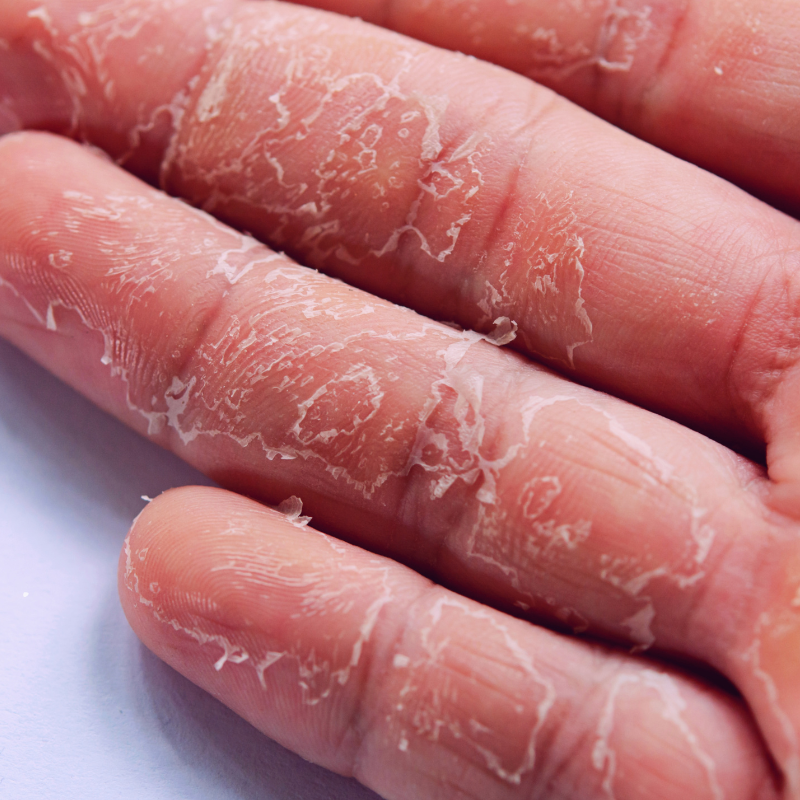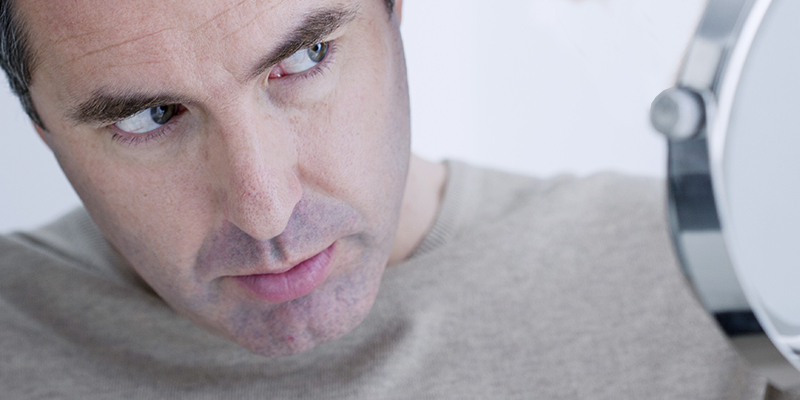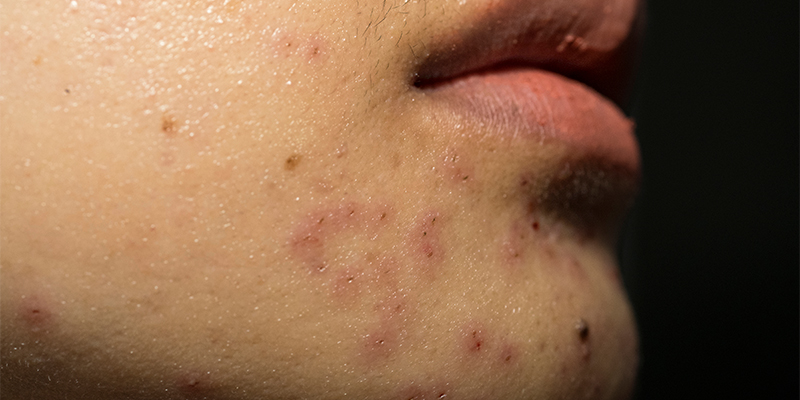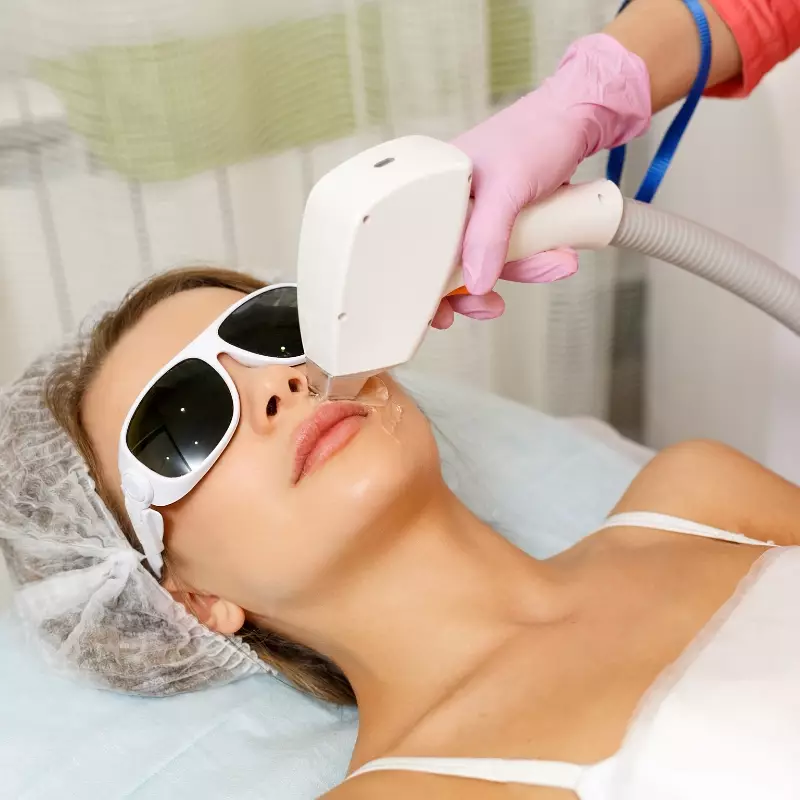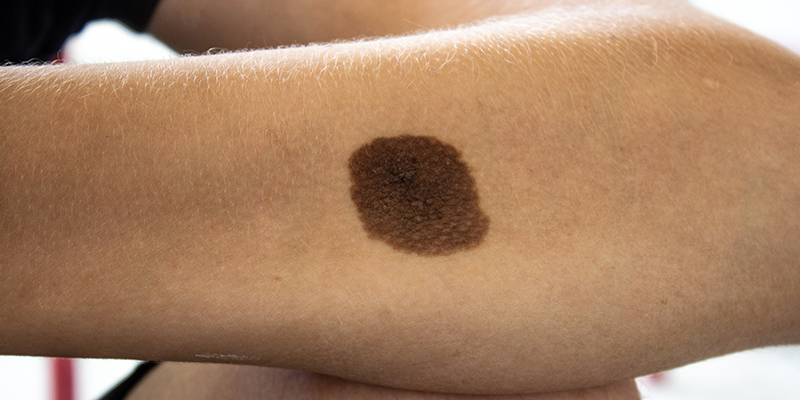Skin Peeling On Fingertips: Causes, Treatments, Home Remedies & Prevention
Skin peeling on fingers, especially fingertips, is a common problem affecting both sexes and all age groups. Skin peeling on fingertips happens due to various underlying reasons like dryness, changing temperatures and weather conditions. Sometimes, peeling of finger skin is a sign of an underlying medical condition, and ignoring it may not be wise. This article dives deep into the various factors that cause skin peeling on fingertips and the treatments available. Additionally, we will also provide some valuable tips to prevent peeling skin around fingers and home remedies that can help you treat this problem. Let us get started.
What Is Skin Peeling On Fingers?
Peeling skin around fingers, also known as desquamation, is a condition characterised by the shedding of the skin on the fingertips. This leads to dryness, cracks, and even the temporary loss of fingerprints. In severe cases, it can be painful and even result in bleeding.
Must Read: Skin Peeling On Face
What Causes Skin Peeling On Fingertips and How Is It Treated?
Skin peeling on fingertips is a common condition that can stem from various factors, ranging from environmental irritants to underlying skin disorders. Here are a few common triggers and the possible solutions to treat them:
Environmental causes
Environmental factors can play a significant role in triggering skin peeling on the fingertips. Dry weather or cold and dry air can strip the skin of its natural moisture, leading to dryness, cracking, and peeling.
Treatments
Using a humidifier can significantly improve indoor air quality by adding moisture, especially during drier months when indoor heating is on. Opting for breathable fabrics in your clothing can help your skin breathe better, reducing excess sweating that can lead to dryness. If you are already experiencing peeling of finger skin, using a gentle soap and a good moisturiser can give you much-needed relief.
Sun Exposure
Excessive or prolonged exposure to the sun can leave your skin feeling hot, tender, and resembling a lobster. The primary cause of this discomfort is UV rays, which can damage your skin cells and lead to peeling of finger skin a few days later.
Treatments
In most cases, sunburns heal on their own, but you can soothe the discomfort and aid the healing process. Applying a cool, moisturising agent like aloe vera gel can help reduce pain and inflammation.
Hot Water
Hot water can contribute to skin peeling on the fingertips. Our skin has a natural protective barrier of oils (sebum) that helps retain moisture. Hot water can dissolve and wash away these oils, resulting in dried skin on fingertips.
Treatments
To minimise the impact of hot water on your fingertips, consider the following tips:
-
- Use lukewarm water
- Limit exposure time
- Moisturise regularly
Hand Eczema
Underlying skin conditions, such as atopic dermatitis (a type of eczema), can also lead to skin peeling on fingertips. This inflammatory condition often appears as irritated skin that might peel, change in colour, crack, itch, or become tender. Exposure to certain substances can trigger eczema skin peeling on hands. Additionally, genetic factors may predispose some individuals to this condition.
Treatments
Managing eczema skin peeling on hands involves a combination of gentle care and protective measures. Opting for mild, fragrance-free soaps and cleansers can help prevent further irritation.
Psoriasis
Sometimes, skin peeling off on fingertips signifies more than just dryness. Psoriasis, a chronic skin condition, can manifest in various ways, including silvery patches or raised bumps on the skin. If you notice peeling skin around your fingers for the first time or experience other unusual skin changes, it is advisable to consult your doctor.
Treatments
Various treatment options are available for managing psoriasis on the hands. These include medicated soaps containing tar, topical treatments with salicylic acid or corticosteroids, and calcipotriene.
Dyshidrotic Eczema
In more severe cases, skin peeling on fingertips could be a sign of dyshidrotic eczema, a persistent form of eczema skin peeling on hands. This condition manifests with fluid-filled blisters on the palms, sides of the fingers, or soles of the feet and is often accompanied by a burning sensation.
Treatments
In some cases, managing the symptoms of dyshidrotic eczema requires prescription medications. Your doctor might recommend a topical ointment or cream containing steroids to reduce inflammation and alleviate discomfort.
Acral Peeling Skin Syndrome
Although uncommon, a rare genetic condition called acral peeling skin syndrome can also lead to skin peeling on fingertips. This condition typically manifests with mild symptoms, predominantly characterised by the painless shedding of skin on the hands and feet.
Treatments
Typically, acral peeling skin syndrome does not require medical intervention unless complications like blistering arise. In such cases, a doctor can provide treatment to prevent infection.
Exfoliative Keratolysis
Exfoliative keratolysis is the common culprit behind skin peeling on fingertips, especially during warmer months. This condition often starts with small blisters that eventually peel, revealing discoloured, dry, and cracked skin.
Treatments
While corticosteroids might not be the best solution for addressing peeling caused by exfoliative keratolysis, opting for emollient-rich hand lotions can offer some relief and promote healing.
Finger Sucking
Thumb sucking is a common cause of skin peeling from thumb in young children. This behaviour is normal for many infants and toddlers, and most eventually outgrow it naturally.
Treatments
If you notice that your child’s thumb-sucking habit is causing skin irritation, such as cracking or peeling, it is advisable to consult their paediatrician. They can offer advice on, how to address the issue, whether simply applying a moisturiser or exploring strategies to discourage the habit.
Chemical Exposure
Even everyday items like cleaning products, detergents, and some hand sanitisers can contain harsh chemicals. These cause dried skin on fingertips, leading to peeling.
Treatments
If you want to take the first step toward avoiding harsh chemicals, consider opting for products specifically formulated for sensitive skin. These formulations avoid fragrances and other common irritants that can be tough on your hands.
Vitamin Deficiencies
A lack of niacin, also known as vitamin B3, can lead to pellagra, a condition characterised by skin inflammation, redness, and peeling, particularly on areas exposed to the sun, such as the hands and fingers.
Treatments
Maintaining a balanced diet rich in vitamins and minerals is essential for overall skin health. If you suspect peeling skin on fingers vitamin deficiency, a healthcare professional will recommend appropriate testing and supplementation if necessary.
Kawasaki Disease
Although uncommon, skin peeling on fingertips could be a symptom of Kawasaki disease (KD), a condition characterised by acute inflammation. This inflammatory response often leads to a rash, swelling and peeling of the hands and feet.
Treatments
The primary treatment approach for Kawasaki disease typically involves a combination of aspirin and intravenous immunoglobulin (IVIG), a type of antibody therapy.
Frequent Handwashing
Although handwashing is crucial for hygiene, overdoing it can lead to peeling fingertips. The frequent use of soap, especially when combined with hot water, can strip away your skin’s natural oils and protective layer.
Treatments
Maintaining healthy and peel-free fingertips starts with using gentle products when washing your hands. However, do not let the fear of finger skin peeling stop you from washing them altogether! Remember, handwashing is our first line of defence against nasty germs that can cause illnesses like the flu or COVID-19.
Allergies
Allergies can definitely cause skin peeling on fingers. It occurs when your skin comes into direct contact with an allergen, which triggers an allergic reaction. The allergens can vary widely and include metals like nickel, some fragrances, and preservatives used in cosmetics. Besides, some plants, like poison ivy, are notorious for causing skin irritation and peeling.
Treatments
If you suspect an allergy that is causing skin peeling on fingertips, it is crucial to consult a dermatologist. They will perform patch tests to identify the specific allergen and recommend appropriate treatment options, such as topical corticosteroids or antihistamines.
Contact Dermatitis
Everyday products we use can sometimes cause skin peeling on fingertips. Certain chemicals in moisturisers, soaps, shampoos, and other beauty products can irritate skin, leading to contact dermatitis.
Treatments
To avoid irritating chemicals, use products specifically designed for sensitive skin. These are free from fragrances and other common irritants.
Dry Skin
Dry skin often causes skin peeling on fingertips, especially in winter when the air gets drier. While taking hot showers or baths can be relaxing, it can strip your skin of its natural oils and exacerbate dryness.
Treatments
A few simple steps can make a significant difference in keeping your fingertips from turning into a flaky mess. A humidifier can help replenish moisture and prevent your skin from drying out when the air gets dry, especially indoors during colder months.
Infection
Hand, foot, and mouth disease (HFMD), primarily known for affecting infants and young children, is a viral infection that manifests occasionally with skin peeling on fingertips.
Treatments
Hand, foot, and mouth disease is a viral infection that usually resolves within a week to ten days. However, the symptoms, like skin peeling on fingertips, persist longer.
Common Cold
Although the common cold does not directly cause skin peeling on fingertips, some associated factors like frequent handwashing and dehydration might contribute to it.
Treatments
Wash your hands with lukewarm water and gentle soap to prevent or alleviate peeling skin around fingers. Also, moisturise regularly after each wash to restore moisture.
Cancer
Some chemotherapy medications used to treat cancer can cause skin side effects like dryness, redness, and peeling. Radiation therapy on the hands or fingers can also cause skin reactions, including peeling.
Treatments
It is essential to note that these are uncommon scenarios, and skin peeling on fingertips most likely occurs by other factors like dry skin, eczema skin peeling on hands, or allergies. However, if you are experiencing unexplained or persistent skin peeling on fingers and other unusual symptoms, you should consult a doctor for proper evaluation and diagnosis.
Home Remedies For Skin Peeling on Fingertips
Are you experiencing mild skin peeling on fingers? Do you suspect it is due to a minor irritant or dryness? Here are some simple home remedies that may offer relief and promote healing.
-
Aloe Vera
Skin peeling on fingertips can cause discomfort, such as burning and irritation. Due to its soothing and cooling properties, applying fresh aloe vera gel can provide rapid relief.
-
Honey
Honey has natural moisturising and antimicrobial properties and is a soothing remedy for skin peeling on fingertips. Its humectant properties draw moisture to the skin, while its antibacterial qualities can help prevent infection in cracked or broken skin.
-
Petroleum jelly
Petroleum jelly can be a simple yet effective remedy for cracked skin on fingertips. By creating a protective barrier, it locks in moisture and promotes healing.
-
Oatmeal
Oatmeal can be an effective remedy for soothing and addressing peeling skin around hand fingers. Rich in avenanthramides, compounds known for their anti-inflammatory properties, oatmeal aids in soothing irritated skin. Additionally, oatmeal’s natural moisturising abilities can hydrate dry and peeling skin, and promote healing.
-
Cucumber
Due to its high water content and cooling properties, cucumbers can offer some soothing and hydrating benefits. They may help alleviate dryness and discomfort associated with the peeling of finger skin.
-
Milk
Milk contains lactic acid, an alpha hydroxy acid (AHA) known for its gentle exfoliating properties. It can help remove dead skin cells, which may contribute to a smoother texture and reduce the appearance of peeling.
-
Banana
Overripe bananas are rich in vitamins and moisture. You can repurpose them into a nourishing hand mask to combat skin peeling on fingertips. Mash a ripe banana and mix it with honey for its antibacterial properties and milk for added hydration. Apply this mixture to your fingertips and allow it to sit for a few minutes before rinsing.
-
Olive Oil
Olive oil can be a beneficial addition to your hand care routine when dealing with skin peeling on fingertips due to dryness. Olive oil can help create a protective barrier on the skin’s surface, preventing moisture loss and promoting healing.
How Is Skin Peeling on Fingertips Prevented?
Prevention is often the best cure for skin peeling on fingertips. Thankfully, there are several simple yet effective measures to keep your hands happy and healthy.
-
Drink water
Adequate hydration is crucial for maintaining healthy skin. Dehydration can exacerbate skin peeling on fingers and dryness, so drink plenty of water and limit dehydrating beverages like caffeine and alcohol.
-
Consider cortisone creams
An over-the-counter cortisone cream may alleviate irritation, redness, swelling, or discomfort associated with skin peeling on fingertips.
-
Moisturiser
Using an unscented moisturiser regularly is a recommended sunburn remedy. It helps hydrate the skin and restores the skin barrier.
-
Use a humidifier
Using a humidifier, especially during dry seasons or in arid climates, can be a game-changer for preventing and relieving skin peeling on fingertips.
-
Exfoliation
Resist the urge to scrub peeling skin, which can exacerbate redness and irritation. Instead, gently pat the skin dry after bathing and moisturise regularly. The peeling skin will naturally shed when the underlying layers are ready.
-
Take a cool bath
Consider taking lukewarm or cold showers or baths to soothe sunburned skin, as hot water can worsen irritation. Opt for gentle, unscented cleansers to minimise further irritation while the skin heals.
-
Analgesic
Analgesics, commonly known as painkillers, can help alleviate the discomfort associated with skin peeling on fingertips, mainly due to sunburn, hand eczema, or other inflammatory conditions.
-
Use sunscreen
Shielding sunburned skin from further UV exposure is crucial, even on cloudy days. Additionally, remember to apply sunscreen diligently to both face and body, regardless of weather conditions.
-
Avoid hot showers
Exposure to hot water can strip the skin’s natural oils, leading to dryness, irritation, and, ultimately, peeling. This is particularly concerning for already vulnerable skin, such as sunburned or eczema-prone skin. Opting for lukewarm showers instead helps preserve the skin’s moisture barrier while reducing the risk of further damage and promoting faster healing.
-
Avoid products that dry your skin
Products that dry your skin can worsen skin peeling on fingers and delay healing. Instead, use gentle, moisturising alternatives to support your skin’s natural recovery process.
-
Dry the face gently
When dealing with peeling skin on the face, it is crucial to treat it with extra care. Instead of rubbing your face with a towel, gently pat it dry to avoid further irritation. This helps preserve any remaining moisture and prevents exacerbating the peeling.
-
Cool Compress
The coolness of the compress can help soothe the burning and itching sensations often associated with peeling skin.
Takeaway
Skin peeling on fingers can result from environmental factors like weather or frequent handwashing. However, it could also indicate a more serious condition, such as hand eczema, psoriasis, or allergies, requiring medical attention. Consult an expert dermatologist if you experience additional symptoms like persistent pain or fever alongside peeling skin.
Frequently Asked Questions On Skin Peeling On Fingertips
How Can I Differentiate Between Normal Peeling And A More Serious Condition?
Normal peeling usually resolves with simple home remedies like moisturisation and skin protection. A more severe condition requires medical intervention to treat it.
Can an immune system disorder cause skin peeling on fingers?
Yes, certain autoimmune disorders like psoriasis or hand eczema can cause skin peeling on the fingers.
Are there any vitamin deficiencies or infections that can cause skin to peel on fingers?
Vitamin B deficiencies (Niacin or Biotin) can cause skin peeling, and certain infections, such as hand, foot, and mouth disease (HFMD), can lead to peeling skin on the fingers.
Can stress cause peeling skin on fingers?
While stress doesn’t directly cause peeling skin, it can exacerbate conditions like hand eczema or psoriasis, leading to peeling.
Are peeling fingertips normal?
Skin peeling on fingertips can be normal, especially if it is a temporary response to dry weather, excessive handwashing, or minor irritation.
How to get rid of peeling skin on fingers fast?
Soak your hands in cool water, pat them dry gently, and apply a thick moisturiser or ointment for immediate relief. Avoid picking or peeling the skin, as this can worsen irritation.
What oil is good for peeling skin on fingers?
Several oils, such as coconut oil, jojoba oil, and olive oil, can be beneficial for peeling skin on fingers.
Does ice help peeling skin from fingers?
No, ice can worsen irritation. A cool compress is a better option for soothing inflammation and discomfort.
How do you treat peeling skin on fingers?
Moisturising and protecting your hands can work wonders for dry or mildly irritated skin. If the condition is more persistent or severe, a dermatologist can diagnose the cause and recommend specific treatments like medicated creams, light therapy, or oral medications.
What is peeling fingers a symptom of?
Various issues can cause peeling fingers. While it might be simply due to dry skin or excessive handwashing, it could also be a sign of more severe conditions like hand eczema, psoriasis, allergies, or certain infections.
Should I wash peeling skin on fingers?
Yes, you should gently wash the peeling skin on fingers with lukewarm water and mild soap to prevent infection. However, avoid harsh scrubbing, as it can worsen irritation.
Will my skin grow back after peeling on fingers?
Yes, in most cases, the skin on your fingers will regenerate after peeling. The outer layer of skin naturally sheds and replaces itself, ensuring new skin will grow back. However, this process will occur until you address the underlying cause of the peeling.
Our certified subject matter experts do extensive research and collate facts from reputed scientific journals and international studies to create informative and engaging articles related to all your dermatology concerns. They strive to help you decipher medical jargon, distinguish fact from fiction and overcome paranoia. Our qualified medical board or expert panel goes a step further to verify these facts based on their rich academic knowledge, vast clinical experience and critical industry insights to ensure you consume only medically accurate content that empowers you to make informed decisions about your hair and skin-care treatments and weight management. Check out our Editorial policy for further details
https://pubmed.ncbi.nlm.nih.gov/30032785/https://www.webmd.com/skin-problems-and-treatments/peeling-fingertips-possible-causes
https://www.cancer.gov/about-cancer/treatment/side-effects/skin-nail-changes
https://pubmed.ncbi.nlm.nih.gov/18461339/


